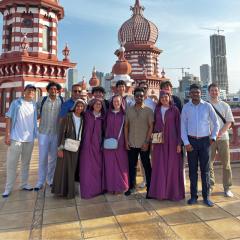This story was written by Dr Simon Albert, Senior Research Fellow at the School of Civil Engineering at The University of Queensland for Nine Digital. View the original article here.
I am passionate about understanding the impacts of climate change on both the natural world as well as on society.
Our team has spent the last decade working on analysing and understanding the influence of sea-level rise on the islands and people of Solomon Islands.
Whilst this work has been published in prestigious international academic journals, working with mainstream media such as 60 Minutes provides a unique opportunity to communicate these issues to a broader audience.
The Solomon Islands provides an incredible natural laboratory from which to study these impacts, as it is on the frontline of sea-level rise with some of the highest rates of rise recorded globally.
Our work involves comparing historical photos dating from World War II with modern-day satellite and drone imagery.
We integrate this information with local traditional knowledge, radiocarbon dating of trees, sea-level records, and wave models to provide an understanding of the role of sea level rise on island dynamics.
More importantly for the rest of the world this provides a glimpse into the window of our climate futures and what to expect in the coming decades.
Whole islands have completely disappeared and turtles that have migrated thousands of kilometres to lay their eggs on sandy beaches cannot climb the last metre of their journey.
Villages that thrived less than 10 years ago have virtually lost all of their houses to the rising waters.
Yet the most important lesson, to me at least, has been the response of the Solomon Islanders themselves. Rather than wilt in the face of such an unstoppable force they are adapting to the changes with what limited resources they have.
Houses have been rebuilt on higher ground, food gardens replanted and they have even helped the turtles, digging up the eggs and reburying them in hatchery areas behind the beach.
The vast majority of the population live in small villages on the narrow strip of flat land immediately behind the beach zone, making Solomon Islands extremely vulnerable to sea level rise.
While their islands and shorelines are vulnerable, I am humbled by the resilience of the people and the practical ways they are adapting to these climate pressures.
It is an honour to be able to learn from these wise, resilient people who are on the front line of such a critical global issue.
I find it inspiring to be able to communicate their stories, to drive the climate dialogue forward from being so bogged down in data and numbers and projections – and try to put a human face on that where possible.
Working with 60 Minutes provides an opportunity to communicate this research, and most importantly, the powerful imagery and local people’s stories to a broader audience in Australia and beyond.
Hopefully this helps the transition from divisive debates of government policy to accepting the global scientific consensus that climate change is real and is fast becoming a humanitarian crisis.
It is society as a whole that will need to solve this global issue that is described as one of humanity’s greatest challenges.
If the people of Solomon Islands can face this head on with their meagre resources, maybe there is a little more we could be doing to help address this climate emergency.
© Nine Digital Pty Ltd 2019



